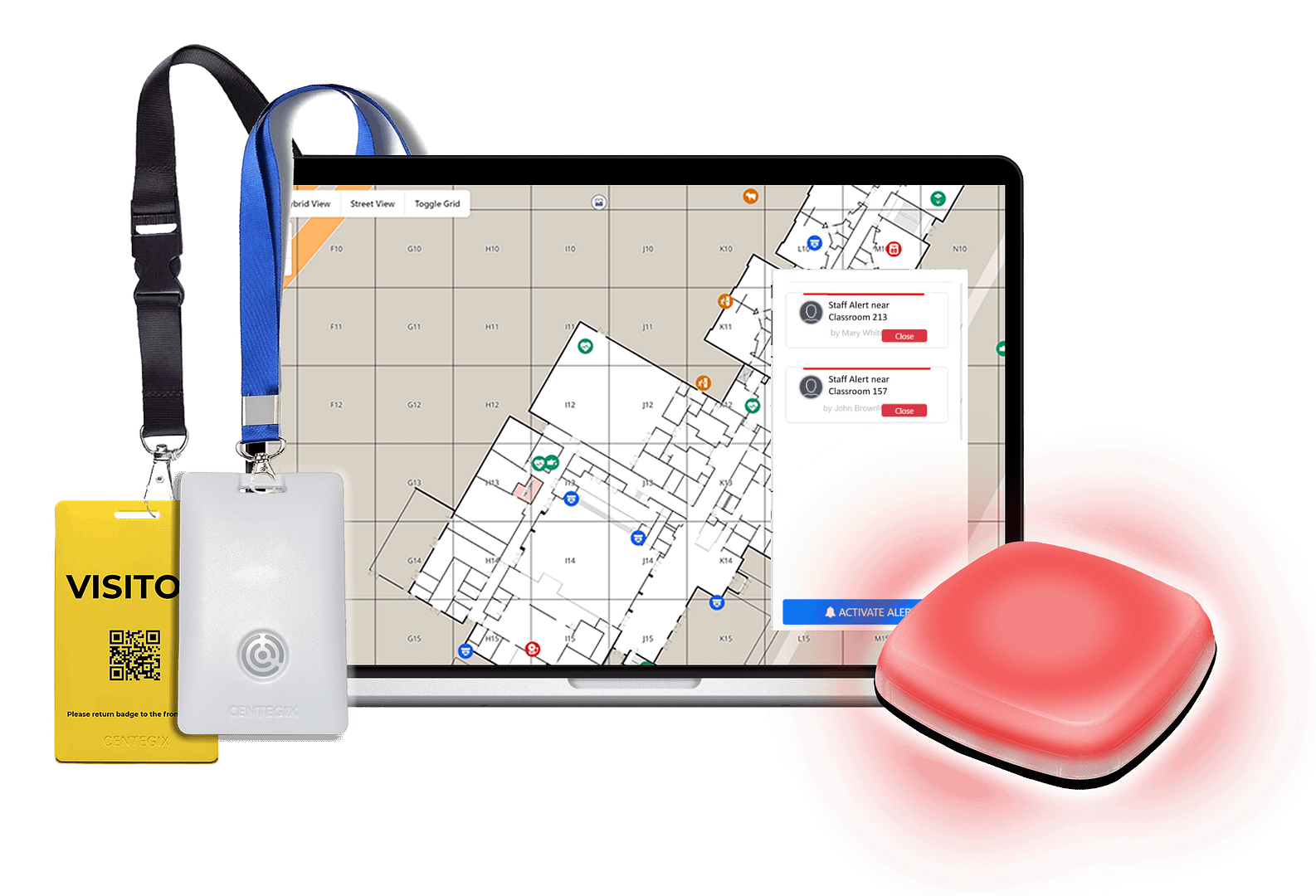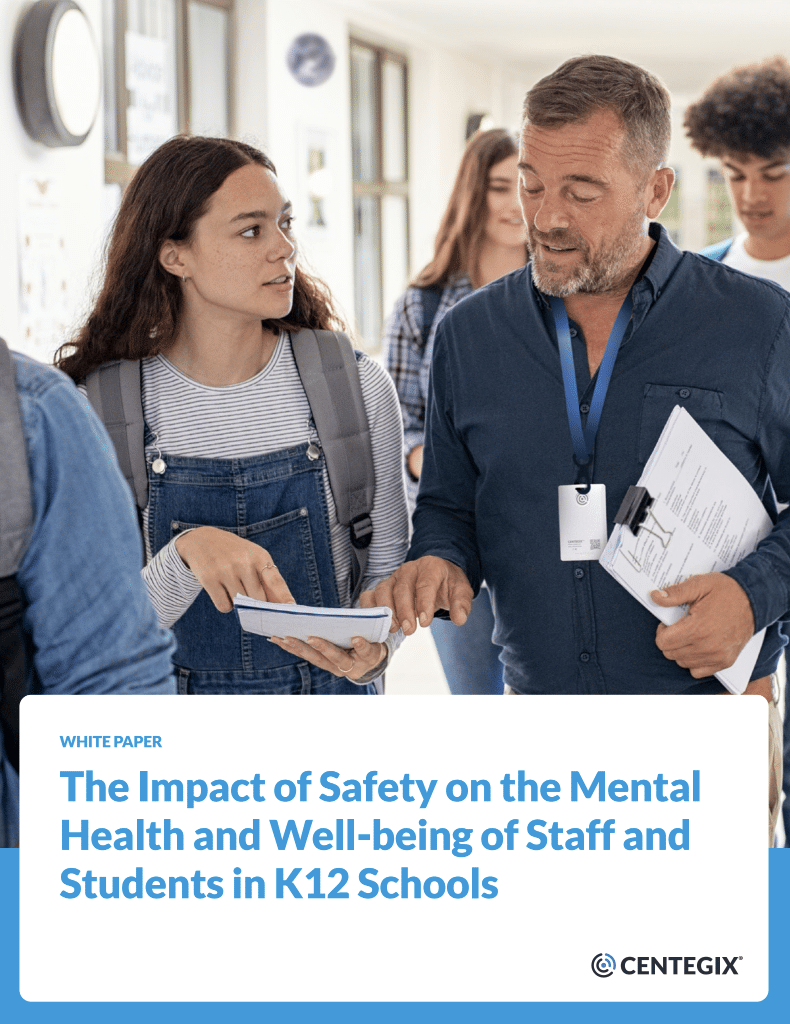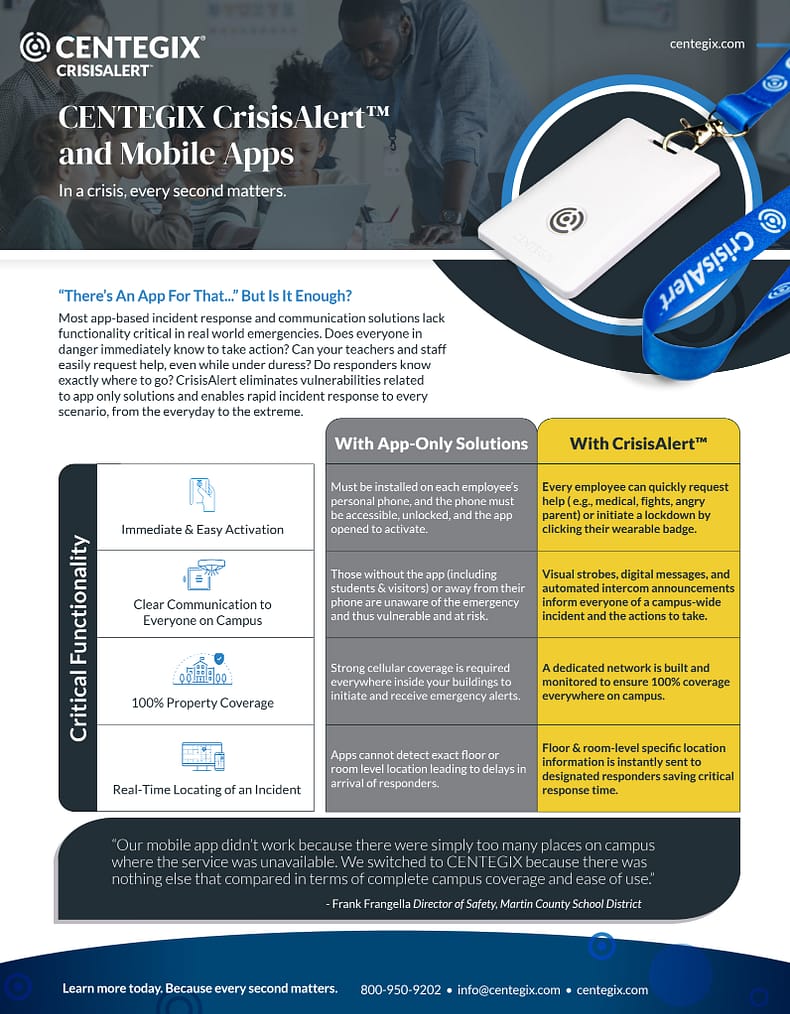CENTEGIX | Education
California School Safety Standards
CENTEGIX | Education
California School Safety Standards
California School Safety Solutions Geared to Prevent Violence
California school alert systems are proactive acknowledgments that school violence has become a modern-day fact of life across the United States.
The K-12 School Shooting Database tracks active shooters around the country. In 2022, there were 303 shooting incidents at schools. One of those shootings claimed the life of a school employee at East Estates School Complex in Oakland.
By California law, school systems need to develop Comprehensive School Safety Plans that should be adopted by March 1st each year to deal with a variety of emergencies:
- bomb threat
- bioterrorism/hazardous materials
- earthquake
- flood
- power failure/blackout
- intruders/solicitors
- weapons/assault/hostage
- explosion
- gas/fumes
California school safety solutions are required to include specific procedures “to prepare for active shooters or other armed assailants.” Training also should be available for staff and students, so they understand how to react in emergency situations.
In addition, plans should include clear guidelines for the roles and responsibilities of mental health professionals, school counselors, community intervention professionals, school resource officers, and police officers on campus.
Statewide School Safety Survey
In 2019, the California Department of Education began a survey to see what kind of California school safety solutions were being implemented at elementary, middle, and high schools across the state. The results were released in November 2021:
- Lockdown—93% of schools conduct one or more per school year. Of those, 63% percent conduct one to two drills, 33% conduct three to four drills, and 5% conduct lockdown drills five or more times.
- Multi-option response, Run-Hide-Fight, Alert, Lockdown, Inform, Counter, Evacuate (ALICE), or Civilian Response to Active Shooter Events (CRASE)—42% conduct one or more multi-option drills per school year. Of those, 68% conduct one to two drills, 17% conduct three to four drills; and 15% conduct five or more drills.
- Earthquake drills—88% conduct one or more drop-cover-hold drills. Of those, 63% conduct one to two drills, 31% conduct three to four drills, and 6% conduct five or more drills.
- Shelter-in-place—82% conduct one or more shelter-in-place drills. Of those, 75% conduct one to two drills, 19% conduct three to four drills, and 6% conduct five or more drills.
- Evacuation—79% conduct evacuation drills one or more times. Of those, 30% conduct one to two drills, 21% conduct three to four drills, and 49% conduct five or more.
- Reverse evacuation (moving people into the facility for safety)—32% conduct one or more reverse evacuation drills. Of those, 80% conduct one to two drills, 9% conduct three to four drills, and 11% conduct five or more.
- Reunification—29% conduct one or more reunification drills. Of those, 66% conduct one to two drills per year, 5% conduct three to four drills, and 19% conduct five or more drills.
Focusing on Prevention
The California Department of Education’s Project Cal-STOP provides free training to schools based on Sandy Hook Promise’s Know the Signs Programs:
- Start With Hello trains middle and high school students on how to recognize social isolation within their classroom and school. Students learn how to reach out and help.
- Say Something teaches middle and high school students to look for warning signs and threats—especially in social media—and to act immediately. Sandy Hook Promise also operates Say Something Tips, a website where students and staff can anonymously submit their safety concerns
- SAVE Promise Club is a student-led club that allows students to practice lessons from Start With Hello and Say Something. The club organizes activities on campus that promote a safe, respectful, and inclusive climate.
Cal-STOP also includes National Alliance on Mental Illness On Campus High School Club and Youth Mental Health First Aid training as ways to give troubled young people the help they need.
Adapting Facilities
While acknowledging that schools shouldn’t be like jails, the California School Boards Association encouraged school districts to take steps to secure buildings as part of California school safety solutions.
The association recommended restricting unauthorized access to schools by limiting entrances and providing extra security for ground-level windows. In order to deter violence, 24-hour video cameras should be placed:
- at school entrances
- in hallways
- in lunchrooms
- on buses
California school safety solutions can include metal detectors to prevent weapons from entering schools. In addition, the association recommends that administrators work with law enforcement to provide on-campus resource officers.
Grants for California School Safety Solutions
Stop School Violence Act & Stronger Connections Grant Program
In December 2021, the United States Attorney’s Office for the Northern District of California announced $125 million was awarded by the Department of Justice under The STOP School Violence Act.
The grants were designed to help primary and secondary schools prevent school violence by training school staff and students and implementing evidence-based threat assessments. Funds were applied to anti-bullying programs and mental health intervention teams.
In addition, the Stronger Connections Grant Program awarded nearly $1 billion to states to provide students with safer and healthier learning environments. California received $119,828,943 from this program.
ESSER Funds
As part of the federal Coronavirus Aid, Relief, and Economic Security Act, Elementary and Secondary School Emergency Relief (ESSER) funds were made available to address the pandemic’s impact on student safety and mental well-being. As of June 30, 2022, California has spent 30% of the total awarded funds.
For the first round of ESSER grants, the state was allocated $1,647,306,127. The deadline to obligate those funds was Sept. 30, 2022.
The Coronavirus Response and Relief Supplemental Appropriations Act was passed in 2020. As part of the act, California’s ESSER II allocation was $6,709,633,866, and it must be obligated by Sept. 30, 2023.
Another round of funding was made available as part of the American Rescue Plan. California’s portion of those ESSER funds is $15,079,696,097, and the obligation deadline is Sept. 30, 2024.
COPS School Violence Prevention Program
The U.S. Department of Justice oversees the COPS School Violence Prevention Program. The money is earmarked for evidence-based school safety programs and technology.
Schools can use those funds to purchase school safety technology that helps identify potential dangers. The money can also be used to improve emergency notification and response systems. The deadline to apply is May 17, 2023. To learn more, visit the COPS website.
BJA'S Stop School Violence Program
The U.S. Department of Justice also has funds available through the Bureau of Justice Assistance. BJA’s STOP School Violence Program funds software that helps K-12 schools maintain a safe environment. It’s geared toward recognizing, responding to, and preventing violence on campus. Applications will be taken until May 15, 2023. Learn more here.
Federal Grants
The list of federal grants awarded to California for the 2022-23 school year includes:
- IDEA ARP, $267,360,513
- IDEA, $1,672,263,265
- Title I, $4,305,989,945
- Title IV-A, $139,925,103
A number of other federal grants are available to help school districts prevent, mitigate, respond, and recover:
- Strategies to Support Children Exposed to Violence—provides funding to assist children and their families exposed to violence. Deadline to Apply: April 24, 2023.
- Project AWARE—funds school-based mental health programs and services. Deadline to apply: April 28, 2023.
- Community Based Violence Intervention and Prevention Initiative—supports evidence-based intervention and prevention programs to address gun violence. Deadline to apply: May 18, 2023.
How Are Your Resources Being Spent?
CENTEGIX protects over 11,500 schools across the country. We can protect your school, too.
The CENTEGIX Safety Platform™, featuring CrisisAlert™, accelerates your response to emergencies. We’ve built the CENTEGIX Safety Platform to support you in the single most critical factor of incident response: time. Because in an emergency, every second matters.
Discover federal resources to fund new safety and security initiatives in your district by exploring federal funding resources for school safety.

CENTEGIX | White Paper
The Impact of Safety on the Mental Health and Well-being of Staff and Students in K12 Schools
When safety leads, success follows.


Partner of AEPA and CalSave
CalSave uses national leverage to seek best pricing on its purchasing contracts. As a participating member of the Association of Educational Purchasing Agencies (AEPA), a multi-state non-profit organization made up of Educational Service Agencies / political subdivisions organized through a Memorandum of Understanding between all participating states, CalSave works with educational purchasing cooperatives in 26 other states. In California, awards are made by MCOE based on the application of California law.
CENTEGIX is a proud AEPA-awarded member in the state of California through CalSave as a Security Solution. We look forward to the opportunity to explore and solve your school safety needs. Learn more here.
Championing Safe Schools with Educators and Educator Associations
Hear from Our Educators
We engage with teachers and staff every day to understand how CrisisAlert supports them, and here’s what they’ve shared:
A student was having trouble breathing and her vision was beginning to black out. We don’t have service in our building and it can be difficult to get ahold of the office staff, so having something to immediately alert them of emergency was incredibly helpful in a very scary situation.
I had a student who was refusing to follow directions and became very defiant. This student was beginning to get aggressive. I used my badge to alert our campus security monitor to remove the student from the situation. It is a very useful tool when the response was as immediate as it was.
A student was having a severe panic attack, trouble speaking, crying, not able to answer my questions as to what was wrong with her. I used the device to call for administrative help and it worked like it was designed to. Help arrived in a matter of seconds. I saw firsthand how well it works.
Discover the Safety Platform
Safety solutions that prioritize speed for the best outcome.
Mapping and locating capabilities provide the precise location—of emergencies, visitors, and safety assets.
A visitor management system screens and locates visitors on your campus.
Protocol development to plan for rapid incident response.
CENTEGIX CrisisAlert vs. Mobile Apps
CrisisAlert eliminates vulnerabilities related to app-only solutions and enables rapid incident response to all emergencies.

In an Emergency, You Need CrisisAlert™
Adverse situations can happen at any moment—from everyday crises such as medical emergencies, severe weather, and physical altercations to extreme situations that threaten your entire campus. The faster you get help to the right location, the better the outcome.
See how our CrisisAlert wearable mobile panic button empowers staff to get help instantly in an emergency.
Ready to Connect with a CENTEGIX Specialist to Learn More?
"*" indicates required fields
*By providing my phone number to CENTEGIX, I agree and acknowledge that CENTEGIX may send text messages to my wireless phone number for any purpose. Message and data rates may apply. CENTEGIX will only send one SMS as a reply, and I will be able to Opt-out by replying “STOP”. **No mobile information will be shared with third parties/affiliates for marketing/promotional purposes.*

Empower Your Educators
with Safety
Explore More Safety Resources
The Impact of Building a Culture of Safety in Schools
Creating a safe and secure environment is of the utmost importance for schools. Safer environments ensure the well-being of students, teachers, and staff.
Improving Student and Staff Outcomes with Incident Response Technology
Medical emergencies can happen to anybody, anywhere. CENTEGIX’s school safety technology is there to protect everyone on campus, at all times.
2023 Safety Spring Trends Report
In this report, CENTEGIX offers its latest, comprehensive analysis of school safety incidents and staff survey feedback gathered from our CrisisAlert usage data for the 2023 spring term.
School Safety Standards by State
Schools in any state can meet school safety grant funding requirements by choosing CENTEGIX CrisisAlert™ solution.
SOLUTIONS
INDUSTRIES
RESOURCES
COMPANY
PARTNERS
CONTACT
EVERY. SECOND. MATTERS.®






























